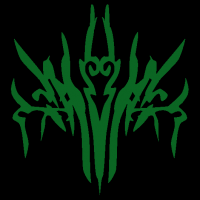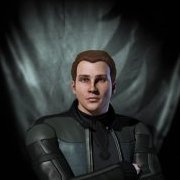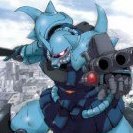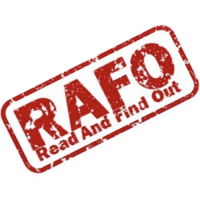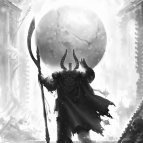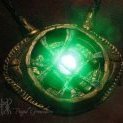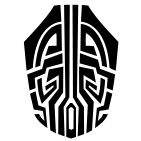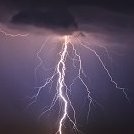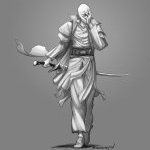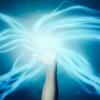Search the Community
Showing results for tags 'intent'.
-
This is more a big "what if" than a theory. Maybe it has been discussed already but I was just wondering... Ati describes himself as "Change", rather than just "decay". Rayse does the same, his religion is the "Passions", and he claims that all "passions" are his. But both are known for the negative aspect of their Intents, Ruin (a kind of change) and Odium (definitively a strong emotion / passion). AFAIK the shards have their own intents, period. But I figured the holder might fine-tune it. Ati might have even tried but failed, given he has been described as a good man. But imagine what kind of story would we have had if instead of Ruin and Preservation, we got Progress and Stagnation, wit these names, the Good/Bad roles seem to be reversed! Or if Odium was Love, could even work as a villain too, Love can be pretty toxic if it devolves into jealousy. Honor might have been Stubbornness. Endowment might have been Martyrdom, always giving herself for others. Heck, Sazed names himself Harmony because he believes he controls two oposite forces, but the forces have him trapped and limit his actions, so they are not very harmonious... He could have named himself Discord, to represent this conflict, if the depressive side of him were the dominant when he took the shards... You get the Idea. As I said it's not even a theory. Ati would not have ended as he did if it were that simple as to change perspectives. But I think it's a fun "what if" exercise.
-
Okay so, time for my first real crackpot theory. We know, from the AU essays that Sel has been gaining a bit of sapience. What if the planet Sel itself caused the Reod, being unhappy with the Elantrians, and the way they were using their power? It would give the Reod more cosmere significance, and it would be interesting, compared to the few things we know about the humans who left Ashyn. As a planet, I could understand Sel not wanting to have something happen to it, and it might have intervened.
-
Lately I was thinking, what exactly would the effect of holding the Shard Ambition be on a person? Or if hypothetically the remnants of Ambition re-coalesced into a sentient, Vessel-less Shard? Because ambition is not something that can really exist in a vacuum, it’s a relational attribute. Ambition in the absence of anything to be ambitious about is effectively meaningless I think. So what exactly does the term mean in the context of the Shard? I would guess that if one were to hold Ambition in addition to another Shard, it would likely have a similar effect to a Blue Lantern Corps member being near a member of another Corps, namely it would act as an amplifier of whatever that Intent is and effectively make them even more fanatical about it (or at least I think that’s a plausible hypothesis), but what about if one was just holding Ambition? It seems like the landscape of possible ways that particular Shard could be channelled is effectively endless, depending on what its Vessel happened to be ambitious about.
-
In the old, pre-Lord Ruler religion centered on him he was supposed to be the god of night, right? And his showy brother was god of the day. But his followers loved his humble ways more than those of his brash brother. Trell works quitely. Whereas Ruin and Preservation had a full-blown war in full view of everyone, Trell moves quietly in the background. His (ostensible) followers in The Set do too. It may be that in Warbreaker the god Austre is actually Trell. Austre seems to have very little connection to Endowment, and Austre teaches his followers to share Trell's quiet, self-effacing ways. So Trell is the shard Modesty (that is, opposite of ostentatiousness). Do you agree?
-
Alright, so we know that not all the Shard's vessels were human. We have humans and at least one dragon and at least one Sho Del (based off of the language in the Ars Arcanum Essays, I would guess there is more than just one of each of those). So the question/theory is: does the species of the vessel effect how much they can resist the influence of their Shard's intent? Are there some minds that are naturally stronger just because of which species they belong too? We have a WOB that says some Vessels are still actively resisting the Shardic influence. We also know from WOBs that some individuals are better at resisting than others. I think the species and strength of the mind could have a significant effect on this, what do you think? (I'll post the relevant WOBs below to keep the whole theory together.)
-
So bear with me here it's my first post on this site, I was thinking of possible shard intents and the idea of regret came to me, I've no evidence or WOB to back this up I just like the idea and think it could make for a very interesting magic system
-
Because all of the Shards of Adonalsium have their own predesignated Intents, I have come to wonder if Adonalsium itself had an Intent of its own before it was shattered. And I believe that Intent, and therefore the name we can ascribe to the power of Adonalsium, is Unity. First of all, this stems from the nature of the religions on Sel, as shown in Elantris. The two dominant religions on Opelon in conflict with one another are Shu-Korath and Shu-Dereth. The way I see it, Shu-Korath relates closely to the Intent of the Shard of Devotion, and Shu-Dereth relates closely to the Intent of Shard of Dominion. Both were killed and Splintered early on Sel, but they still have a great influence on Sel, not just in the form of seons and skaze, but in the form of religious precepts. And what is it the Korathi and the Derethi are both striving for in the world? Unity. They seek to unite all people, but in different ways. The Korathi preach love, the Derethi preach control. Unity through Devotion. Unity through Dominion. Of course, this could be seen as the effect of people’s interpretations of Intent rather than Shards themselves, so who knows. My second point is a rather weaker one, relating to Scadrial and its Shards. When Ruin and Preservation are combined into one, they for the dual Shard of Harmony. It is a perfect Unity of the two most opposing Intents. If anything, I consider unity and harmony to be synonymous one with another (and so does the thesaurus ). Third of all is in the Stormlight Archive, Honor repeats the same command to Dalinar in each of his visions – Unite them. It almost even seemed a bit out of character to me that the dead Shard seemed to care more about unity on Roshar rather than the honor of mankind. We don’t even know entirely what he means by that phrase, but it is his ever-present plea. Unite them. Whatever it means, Honor desires unity of some sort. And in Oathbringer, it reaches a culmination that seemed to be set up from the start of the series. The previous points could be considered speculation, but this is a real example in the books that works as evidence. The linchpin for this theory is the climactic scene in Oathbringer in which Dalinar swears his third Ideal, opens Honor’s perpendicularity, and is referred to as having Ascended. When Venli asks him who he is, he responds, “I am Unity” before uniting the three Realms. This seems to go along with what Honor’s visions have been saying to him. The interesting part is this: it’s right after he says those words and brings the Realms together that Odium steps back in fear and rage, saying, “No, we killed you! WE KILLED YOU!” Now, why would he say that in direct response to Dalinar calling himself Unity? At around that same time, Dalinar remarks to himself that Odium suddenly seems small compared to him. It seems to me that in that moment, Dalinar somehow took up a bit of Adonalsium when he briefly Ascended and somehow knew it, which was why he referred to himself with the title of “Unity”. There are even moments in the series before and after that scene where he describes feeling a warmth and a light that comes from somewhere beyond, something different from Honor. It makes me think that the voice telling him to “unite them” may not even be Honor’s. And if it is, it seems to bear the touch of Adonalsium. On Roshar, Dalinar is meant to “unite them” to save humankind. On Sel, the religions based off the two Shardic Intents are looking for unity through devotion and dominion. On Scadrial, Sazed has become the unified form of two Shards as Harmony. As shown by these three series, unity seems to be a big driving force in the cosmere, one closely related to some of the Shards and perhaps something beyond even them. Why? Because I think Unity was the Intent of Adonalsium, and that it has left its touch on the Shards even after all the time it was Shattered. So my next big question is – if the ultimate power of the cosmere was the godly embodiment of unification, then why would people want to divide it? But hey, that's just a theory. A Cosmere Theory! Thoughts on this theory as a whole? TL;DR: Adonalsium had the Intent of Unity, with possible evidence given in Elantris, Mistborn and the Stormlight Archive.
- 27 replies
-
26
-
My question has to do with how the use of stormlight is supposed to restore the physical aspect of the Radient back to the way their spiritual aspect views itself. I have this weird thing where I don't really remember what people look like until I see them again (it's not face blindness), and it applies to me as well. When I'm not looking in the mirror, I have a lot of trouble remembering what I look like when I'm not staring at myself in the mirror. As a result, my mental image of myself is like a larger version of the way I looked when I was a child. So, if I or someone like me formed a nahel bond and gained the ability to draw in stormlight to heal, do you think they would be restored to their mental image of themselves rather than how they look physically? Does such a strong mental imprint count as being part of the spiritual aspect of a person? What if the Radient had never looked into a mirror or suitably reflective surface; would their spiritual aspect of themselves be closer to the way they see themselves or the way they're actually put together?
- 3 replies
-
4
-
- investiture
- intent
-
(and 4 more)
Tagged with:
-
So in Secret History, Keslier is unable to assume the powers of Preservation, even for a short time, because he is insufficiently Connected to Preservation. However, he is a full Mistborn with no hemalurgic spikes, and allomancy is of Preservation. Does this mean that an important way to forge Connection with a shard is by embodying its intent? That's the only thing I can think of that matches these facts. And if this is the case, can you forge Connection with a shard not present on your planet in this way?
- 4 replies
-
- connection
- intent
-
(and 1 more)
Tagged with:
-
We see on multiple worlds that the intent of a Shard is directly related to how the magic system on that world functions: Awakening on Nalthis is the giving of Breath to something else; bonding a spren on Roshar requires honoring oaths; end-positive Allomancy and end-negative Hemalurgy on Scadrial; etc. So, how is Sand Mastery related to the intent of Autonomy?
- 3 replies
-
- shards
- magic systems
-
(and 2 more)
Tagged with:
-
I theorize each Shard has its own “pathway to power.” This pathway is the conduit down which a Shard’s Spiritual Realm power enters the other Realms. Each pathway is a unique medium for the transmission of magical energy between the Realms. Metal, spren, water, and electromagnetic radiation (EMR) are examples. The idea and term “pathway to power” comes from Marasi’s POV in this Bands of Mourning passage (Chapter 28, Kindle p. 359, emphasis added): Here’s how I think pathways work in my magic systems model: 1. A magic user consumes a “catalyst” to start the magic (burns metal, infuses Stormlight, dehydrates, drains “color,” etc.) 2. The catalyst activates each Shard’s pathway to Spiritual Realm power. 3. The Spiritual Realm releases power down the pathway. 4. Each magic system’s Focus shapes the pathway to choose which power is released. 5. The Focused power Invests the magic user. 6. The magic user directs the Invested power for some magical effect. Brandon says, “The 'role' of the Shard has to do with the WAY the magic is obtained, not what it can do [emphasis added].” Elsewhere he says, @Jofwu calls the “unchanging/unchangeable” aspect of a Shard its “nature.” Because power isn’t “related to the Shards,” I believe a Shard’s pathway solely causes its nature. Each pathway transmits power differently. Ruin could use the same powers as Preservation; but Ruin’s increased net entropy pathway (“decay”) directly opposes metal’s crystalline molecular pathway (“stasis”). It’s “more natural” for Ruin to steal Allomantic powers by increasing net entropy (spiking). Jofwu calls a Shard’s changeable aspect “the Vessel’s expression of the Shard.” I think the Vessel’s expression embodies Brandon’s axiom that perception guides the use of power. IMO, a Vessel’s expression decides “the WAY the magic is obtained,” “the means of getting powers”: “Ruin stealing, Preservation gifting.” Ruin, for example, could give magic users power in ways other than spiking to express entropy. Brandon may have “flavored” pathways and expressions to correlate with Adonalsium life stages, a Jordan-esque “Wheel of Life.” I’m going to try to weave each Shard into a matrix of expressions, pathways, energy transmission mechanics (each pathways’ “science”), life stages, and narrative. I list the Shards in order of their “life stage.” Lots of speculation here. Enjoy the ride! Fortune [SPECULATION] Expression: Grants Foresight Pathway: Space-Time Continuum Mechanic: Special and General Relativity Life Stage: Conception Narrative: Adonalsium conceives the Physical Realm as a space-time continuum We don’t know whether “Fortune” is a Shard, but it’s a good candidate as hinted by its name. Here’s some speculation: Space-Time in the Cosmere Fortune tells Hoid (the most accomplished seer, says Azure) where and when he needs to be, but not why. It sounds like Hoid taps into the cosmere’s space-time continuum. Brandon believes in probabilistic time: “Possibilities upon possibilities, compounded upon one another. Infinite, overwhelming. The future.” (M:SH, Part Three, Chapter 3, Kindle Locs. 1055-1056.) Since our physics and the cosmere’s are the same except for Investiture, I think space-time constitutes the Physical Realm’s fabric, the substance that permeates the Physical Realm. Except possibly for Cognitive Realm splinters, Adonalsium’s mind and soul are alone until he creates the Physical Realm. IMO, conceiving space-time must precede the Physical Realm because the Physical Realm begins linear time, something unknown in the Spiritual Realm: “Time…had no relevance here. It was not a place. Location had no relevance. Only Connection…” (M:SH, Part Three, Chapter 3, Kindle Locs. 1031-1032.) IOW, space-time doesn’t exist in the Spiritual Realm except as a Connection between a soul and its place and time. How Fortune Works? Surprised by the Diagram’s accuracy, Odium tells Taravangian, “You did this without access to Fortune, or the Spiritual Realm?” (OB, Chapter 122, Kindle p. 1215, emphasis added.) This suggests accessing Fortune is an alternate means of seeing the future, different from looking directly into the Spiritual Realm like Kelsier does in M:SH. Fortune seems to avoid the “mind-breaking” Preservation warns Kelsier about. I think Riino’s globe (the “Rii Oracle”) is an example of an “interaction with nature” magic system. “Invested” mortals like Kaladin can interact with Fortune, but they can’t direct its magic. The Oracle seems filled with Fortune’s Investiture (a “milky light” that changes colors, unlike the Ire’s “blue-white light.” (M:SH, Part 5, Chapter 2, Kindle Loc. 1356.) Touching the Oracle IMO Connects Kaladin to space-time. Through that Connection, Kaladin sees Dalinar’s future confrontation with Odium in Thaylen City. Riino later places his bartered Stormlight in “some kind of globe.” (OB, Chapter 99, Kindle p. 926.) If this “globe” is the Oracle, it’s possible Riino needs to replace Stormlight Kaladin consumes to Connect to Fortune. This makes thermodynamic sense, because you need energy to access the Spiritual Realm, even “at the beginning of the highstorm…when realms blend.” (OB, Chapter 97, Kindle pp. 910, 911.) IOW, Kaladin may have accessed Fortune by consuming a Stormlight catalyst the Oracle holds to fuel his Connection to the Spiritual Realm. The Oracle’s magic to me resembles Aviar as much as atium. Aviar warn their bonded mortals about imminent danger. The Oracle sees farther than Aviar or atium, as we might expect from Fortune. Like Aviar, the Oracle creates a Cognitive Connection with Kaladin – the Investiture seems to know he’d want to see Dalinar’s dilemma. Other Thoughts It’s unclear whether Fortune has its own Shardworld. It may be the “Shard that isn’t on a planet,” appropriate for the Shard whose pathway is space-time. Maybe black holes are Fortune’s perpendicularities? I’m curious if we’ll find mortals who can direct Fortune’s magic along its space-time pathway – starship navigators like Dune’s Guild? Fortune may make FTL space travel possible, through black holes or as a navigation guide. FWIW, Feruchemical “Fortune” and the Shard Fortune (if there is one) may not be 100% the same thing: “when they use the word ‘fortune,’ do they mean exactly what the Feruchemical – and the answer is no. But it is a very similar concept.” Endowment Expression: Grants Life Pathway: Electromagnetic Radiation (EMR) Mechanic: Quantum Mechanics Life Stage: Birth Narrative: Adonalsium creates the cosmere: “Let there be light.” Quantum mechanics describes the behavior of matter and energy at the level of atoms and subatomic particles. Photons are a quantum of light. Breaths are essentially a quantum of Investiture. Quantum mechanics metaphorically fits the “Let there be light” moment, as does Endowment’s EMR pathway. Brandon says Endowment wants to start a cosmere market for magic. She creates Breaths by, IMO, adding life to photons, the “bio” in “biochroma.” Each Breath grants more life (the Heightenings). Even non-Nalthians can hold Breaths. This portability, Breath scarcity (related to the number of native Nalthians), and the fact Breaths as quanta are Investiture’s smallest usable “unit,” make Breaths the ideal currency for Endowment’s magic market. I believe that’s why Endowment chose Nalthis to reside on. I characterize Endowment as an “angel investor.” Her investment (uncoincidentally IMO) gives birth to the magic market. Endowment “endowed” Nalthis with a nest egg that, “Invested” wisely, could generate wealth for millennia. Her name shows how she interprets her pathway. Her social endowment includes the Returned, the prophetic avatars of her divine ideals. Devotion Expression: Sustains Life Pathway: Sub-Surface Ground Mechanic: Geothermal Energy Life Stage: Newborn Narrative: Adonalsium creates planets AonDor seems particularly location-dependent even for Sel. To me, Elantris resembles a newborn who fully depends on its mother. Aon Rao infuses Elantris and Elantrians with the Dor (like mother’s milk). Once the Shaod takes them, Elantrians don’t need any other form of sustenance – Devotion “nurtures” them eternally. The broken chasm line deprives Elantrians of their ability to heal and draw Aons, but they remain immortal. Elantrians lose Aon Rao’s power amplification as they distance themselves from Elantris (and their mother’s Spirit). I associate planet formation with Devotion. After its sun, a planet’s secondary energy source is geothermal energy, left in a planet’s mantle and core when formed. (The warmth of a mother’s love?) Geothermal convection at a planet’s core causes tectonic plate movement on a planet’s surface, like what happened with the chasm. I believe Devotion and Dominion chose Sel because their pathways and mechanics suit a world that (IMO) holds Adonalsium’s inherent Investiture in its ground. Honor Expression: Makes Cognitive Connections Pathway: Neural Synapses Mechanic: Synaptic Plasticity – affects the strength of synaptic connections Life Stage: Infant Narrative: Adonalsium begins to Connect his creations into Spiritwebs Infants start to explore and Connect to the people and things in their world. Neural synapses are how the brain makes Connections. Synapses are the gaps between neurons across which the neurons electrically communicate. IMO, synapses are Honor’s pathway. “Synaptic plasticity” refers to the ability of synapses to strengthen or weaken over time in response to synaptic activity levels. Perceived Connections between people, planet and things, reinforced with use, strengthen synaptic connections. Spren enter the Physical Realm through a Cognitive bond with their host. I believe Roshar’s spren bonds attracted Honor to Roshar. Surgebinders get Honor’s magic from the Nahel bond, a form of Cognitive Connection. IMO, oaths reinforce the Connection by strengthening the synapses in the KR’s brain hooking him to his ideals (the Radiant spren). Broken oaths end the synaptic Connection, leaving a mindless spren that’s missing “a piece of [its] soul.” Dominion Expression: Sets Rules Pathway: Ground Surface Mechanic: Gravitational Potential Energy Life Stage: Toddler Narrative: Adonalsium creates the cosmere’s “unifying laws” Dominion’s form-based “programming” gives access to the Dor. IMO, these forms are 2-dimensional representations of local landscape features, an “overlap between language, location, and magic on the planet…” (AU, “The Selish System,” Kindle p. 18.) On Sel, each unique magical population culturally interprets its native landscape. I think these interpretations become Dominion’s forms. My choice of gravitational potential energy for Dominion’s mechanic may seem weird. Potential energy is stored energy that doesn’t do anything until motion turns it into kinetic energy – like a rock that begins to tumble. Gravitational potential energy depends on the relative height of different parts of the landscape. Even minor elevation differences can yield energy. On Sel, “Vast continents and sweeping oceans create a diverse landscape, with an extreme amount of variation on this one planet.” (AU, Kindle p. 17, emphasis added.) Khriss describes “powers that permeate the landscape.” (AU, Kindle p. 17.) I speculate Dominion’s landscape-based access codes unlock Sel’s gravitational potential energy. At least some Selish magic seems activated by motion: Elantrians draw, JinDo dance, and Bloodsealers and Forgers impress essence stamps. Is Forton’s potion stirred? Perhaps this motion converts the potential energy into the kinetic energy that summons the Dor? Other Shardworlds’ magic systems don’t seem to start with motion. Linking gravitational potential energy with the toddler stage seems appropriate. A sedentary infant’s potential energy becomes the mobile toddler’s very kinetic energy as they learn to resist gravity and move. As the toddler’s world expands, authority needs to set boundaries on that energy. Dominion says, “Know your land and take dominion over it before you can extract its magic.” Cultivation Expression: Transforms Pathway: Life Mechanic: Evolution Life Stage: Puberty Narrative: Adonalsium “transforms” the cosmere to create life I leave Cultivation’s “life” pathway vague. If all cosmere life existed only in the Physical Realm, her pathway might be “living cells.” But spren, seons, and skaze are alive too. I believe Cultivation’s life pathway also winds through them. I think Roshar’s spren are the pathway that brings Cultivation’s power to Roshar’s native flora and fauna, the KR, and fabrials. Stormlight activates the spren pathway to manifest the power each spren personifies (fire, wind, gravity, growth, etc.). Khriss says, “this pattern (the bonding of spren to human) is merely an expansion of what already exists in the nature of the planet.” (AU, “The Rosharan System,” Kindle p. 536.) I believe Cultivation causes this “expansion.” IMO, Radiant spren are Adonalsium spren until Cultivation transforms them. Mutation is an evolutionary process. To me, the source of a KR’s power is the Radiant spren, made from some combination of Honor's and Cultivation's Investiture. The Nahel bond’s Cognitive Connection gives the KR the ability to direct the Radiant spren’s power and enjoy power’s benefits (like self-healing). I believe Cultivation also transforms Dalinar, Taravangian, Lift, and Renarin to help them resist Odium. Dalinar recovers his memories in time to assimilate and integrate them before Odium uses those memories to assault him. Cultivation knows Odium will come to Taravangian on his "bad" days, and I suspect Taravangian’s compassion – his Connection to others – will aid him. Cultivation changes Lift so she can metabolize food into Stormlight. Cultivation (IMO) changes both Renarin and Glys so they can bond each other. Renarin's name shows his uniqueness: “Like one who was born unto himself.” (OB, Chapter 52, Kindle p. 515.) Puberty transforms a person and makes them capable of creating life. That seems the natural life stage for Cultivation’s expression and pathway. Autonomy Expression: Grants Self-Sufficiency Pathway: Water Mechanic: Fluid Mechanics Life Stage: Parenthood Narrative: Adonalsium makes a planet with (IMO) its own self-sufficient consciousness Life needs water for self-sufficiency. Like Autonomy, water easily changes form. Autonomy prefers ocean worlds like Taldain and First of the Sun. Fluid mechanics (which includes aerodynamics) seems an appropriate choice for Bavadin, whom I believe is a shape-shifting dragon. Khriss says a Sand Master’s body water forges a temporary bond between him and the sand microflora. (AU, “The Taldain System,” Kindle pp. 369-370.) This bond lets the Sand Master draw Investiture from the Spiritual Realm to control the microflora’s growth and, consequently, the sand. IOW, water is the pathway down which the Sand Master pulls power from the Spiritual Realm and pushes it into the microflora. Brandon calls Roshar a “created” world. I think Adonalsium made Roshar last. The closeness of Roshar’s Cognitive and Physical Realms suggests Adonalsium gave Roshar its own self-sufficient consciousness. Roshar may represent Adonalsium’s Planet 2.0, a child planet that will grow itself. Roshar, FWIW, is also an ocean planet. I think the Urithiru basement icon of a figure with arms out-stretched above a blue disk refers to whatever consciousness raised the Rosharan continent from the water. Autonomy later does the same when its avatar raises the Pantheon. I suspect much of Autonomy’s “assigned Investiture” is found on Roshar. Preservation Expression: Maintains Stasis Pathway: Metals Mechanic: Metal Science Life Stage: Middle Age Narrative: Adonalsium is content with the cosmere as is Metals form regular crystal structures and have the lowest entropy of the matter states – closest to stasis. Adonalsium looks at his creation (the cosmere) with middle age’s self-satisfaction. He wants to keep what he has. Odium Expression: Breaks Cognitive Connections Pathway: Neuron Death Mechanic: Nonsynaptic Plasticity – affects neurons’ intrinsic excitability; overexcited neurons can cause cell death Life Stage: Later Age Narrative: Adonalsium ages, loses Connections, and foresees his death As people age, they lose Connection with family and friends. They become less responsive and lose their affect. Perhaps the Fain causes Adonalsium’s slippage – is the Fain a Physical Realm representation of Adonalsium’s Cognitive decline? Does Adonalsium foresee the need for heirs? I believe Odium’s magic users get their power by breaking their Cognitive Connections to other people. That’s my lesson from Odium’s failed attempt to turn Dalinar. Empty of feeling – “Alone…So alone” – Odium’s magic users fill their void with power. “Passion” can break these Connections – hate blinds, as does lust, gluttony, and shame. Though not passion, irresponsibility also breaks Connections – “It’s not my fault…” I think Odium’s pathway is neuron death. One way: high neuron stimulation over time (like from passion) can overexcite and kill neurons (“excitotoxicity”). To regain their power, a returned Fused IMO must lose more neurons to break more Connections. This may explain why many Fused can’t speak and appear imbecilic – they’ve come back so often and suffered too much brain damage. Odium is the Shard murderer. He kills the Vessel’s mind, leaving the Shard’s power undirected. IMO, Odium holds “the most frightening and terrible of all the Shards” because of his neuron death pathway. Ruin Expression: Decay Pathway: Increased Entropy Mechanic: Second Law of Thermodynamics: Entropy Life Stage: Death and Decomposition Narrative: Adonalsium dies and “decomposes” – Shatters into 16 pieces of greater entropy “Hemalurgy has a huge cost, ending in net entropy,” since power is lost in attribute transfers. I think a Hemalurgical victim’s decaying blood and Feruchemical attribute conversion into Investiture are examples of Ruin’s pathway of increased entropy. Hemalurgy uses metal as a Focus, but metal is Preservation’s essence, not Ruin’s. I think Ruin uses metal because it has the lowest entropy. Other choices would lose too much power in transit. To me, it makes thematic sense the Ruin-Preservation war should oppose entropy with the cosmere’s most entropy-resistant substance. Ruin ruined Ati. It decayed his will and personality until he gave in to Ruin’s destructive impulse. In Ati more than any other Vessel, nature and expression merged. Other Shards I omit Ambition because we only know its magic inferentially. I also agree with many posters that Wisdom is a Shard, but again, we don’t know its magic. I can certainly envision Ambition and Wisdom as Adonalsium “life stages.” Ambition falls between “self-sufficiency” and middle age. Wisdom should come between middle age and Cognitive decline (or so I’m told). Other Topics I discuss these topics in the following Spoiler: Recent WoB Supports Pathways Theory Meaning of “Essence” “Catalyst” as Cosmere Word Why Non-Metal Catalysts Are Invested The Role of Catalyst in Cosmere Thermodynamics: Awakening Catalysts and Identity
- 12 replies
-
10
-
My theory is that Ambition is the most dangerous shard and will eventually reform. But lets first examine what we know about Ambition and Shards in general. Shard come from the shattering of Adonalsium, which seems to have been a last ditch effort. The people who did it seemed really scared and that is why they did such an extreme thing as breaking a god. We know that a vessel is slowly taken over by the intent of its shard. What we know about Ambition: She was killed by Odium shortly after the Shattering of Adonalsium and atleast some shards think, that it is for the better. Now she is splintered. Ambition is defined as "an earnest desire for some type of achievement or distinction, as power, honor, fame, or wealth, and the willingness to strive for its attainment" (dictionary). So where can you go when you are already a shard of a god and extremely powerful. The only logical thing is that Ambition would at some point have tried to accumulate all the shards power and to recreate the power of Adonalsium. ( And then perhaps try to take on his opposing force, which could have catastrophic consequences. ) Which the vessels are strictly opposed too. Not only did the shatter Adonalsium in the first place, they even made a pact to settle different planets. I know that merging shards powers would result in a changed intent, but that should take an equally long time as the take over of the original intent. What makes her more dangerous than Odium is, that Rayse doesnt want to accumulate the other shards powers, he just wants to destroy them. But Ambition is splintered. And here the second letter from Oathbringer comes into play. Im just going to quote it here for ease. Cephandrius, bearer of the First Gem, You must know better than to approach us by relying upon presumption of past relationship. You have spoken to one who cannot respond. We, instead, will take your communication to us – though we know not how you located us upon this world. We are indeed intrigued, for we thought it well hidden. Insignificant among our many realms. As the waves of the sea must continue to surge, so must our will continue resolute. Alone. Did you expect anything else from us? We need not suffer the interference of another. Rayse is contained, and we care not for his prison. Indeed, we admire his initiative. Perhaps if you had approached the correct one of us with your plea, it would have found favorable audience. But we stand in the sea, pleased with our domains. Leave us alone. We also instruct that you should not return to Obrodai. We have claimed that world, and a new avatar of our being is beginning to manifest there. She is young yet, and--as a precaution--she has been instilled with an intense and overpowering dislike of you. This is all we will say at this time. If you wish more, seek these waters in person and overcome the tests we have created. Only in this will you earn our respect. So it is written by somethingwith multiple pieces ( one who cannot responed, we will take your communication to us ). The begings admire Rayses initiative, which sounds very similar to Ambition and they say, that Hoid can earn their respect through overcoming tests, which also sounds like something ambitious to undertake. Obvoiusly I believe that the splinters of Ambition are the authors of this letter. But the most interesting parts are: "A new avatar of our being is beginning to manifest" "As the waves of the seas must continue to surge, so must our will continue resolute. Alone." I think the splinters of Ambition are trying to reform the shard of Ambition with this new avatar on Obrodai and then become the only being (will) in existence. The last part is a bit out there, but I thought i would mention it. So how could Ambition reform from her splinters ( The both the original vessel of Ambition and the new avatar are female. )? I think it will probably be a mini version of Odiums fight against the over shards with one splinter of Ambition fighting the other, merging with it, until only one remains, which will merge with the avatar and become the new Shard of Ambition. I would go so far as predicting, that Ambition 2.0 will not need to overcome the vessels psyche as they specifically created her for that purpose and seem to be able to influence her. ( dislike of Hoid ) TL,DR Ambition will reform on Obrodai and cause major trouble in the cosmere. What do you think about this theory? Am I onto something or is this complete garbage?
-
I'm not sure if anyone has thought about or come up with something like this already, but from the discussion I read through no one had a very feasible name created for the “survival shard.” Brandon has stated that it just wants to hide and survive (the probable intent of the shard) and that it would be partnered with devotion to do something good. With that in mind, I was thinking of something along the lines of either salvation or protection. Both of these things I feel could partner with devotion nicely to form something similar to defense. I just wanted to rekindle this conversation and try to have a look at it from a different point of view. Thanks!
- 15 replies
-
1
-
- shard
- survival shard
-
(and 2 more)
Tagged with:
-
Happy New Year, everyone! Best wishes for peace, health, and prosperity! @Calderis’ excellent post concludes “the names of the Shards that we know is not the pure intent of the Shards themselves, but the interpretation of that core concept by their Vessel.” I agree with his insight. This post tries to describe those “pure intents” (what I call Mandates) and suggests Mandates together may form a specific pattern. Theory IMO, Mandates are each Shard’s thematic mechanic, the way mortals get magic from their Shard: “The means of getting powers…are related to the Shard, but not the powers themselves”; and “The 'role' of the Shard has to do with the WAY the magic is obtained, not what it can do.” As thematic mechanics, “pure” Mandates seem to associate with different stages of life – birth, growth, plateau, decline, and death. I think Mandates together may form a “Wheel of Life” (really), but I’m unsure what that means, if anything. Maybe it’s Brandon’s paean to Jordan? Brandon says Adonalsium could have Shattered differently. At minimum, the allocation of Adonalsium’s power by life stage seems to ensure the Shards don’t overlap. As Evi says, “We are all different aspects of the One.” (OB, Chapter 36, Kindle p. 372.) Mandates divide the One’s magical aspects into different gods. Each Shard’s Mandate I list the Mandates – how IMO a Shard gives its magic to mortals – in order of placement on the Wheel of Life. Grants Life (Endowment) Conception/Birth: Endowment’s Mandate gives life (Breaths). Breaths attach to new souls. Each later-acquired Breath gives more life to souls (the Heightenings). Divine Breath gives life to souls by healing them. Awakening’s Breath transfer gives objects life. Sustains Life (Devotion) Newborn: Devotion uses the Dor like mother’s milk to sustain Elantrians without other nourishment. Elantrians get the Dor through Aon Rao’s infusion of Elantris. Elantrians lose power as they travel from Elantris and their mother’s Spirit. Makes Cognitive Connections (Honor) Infant: Infants begin to form emotional attachments. Surgebinders get Honor’s magic through the Cognitive Connection of the Nahel bond. Sets Rules (Dominion) Toddler/Child: As the child’s world expands, authority begins to set rules and boundaries. Dominion’s programmatic forms set the rules by which Sel’s mortals get the Dor. Transforms (Cultivation) Teenager: The child transforms to an adult. IMO, Cultivation transforms native spren into potential Radiantspren. I think honorspren are Nahel-bondable windspren; Cryptics are Nahel-bondable creationspren; etc. Surgebinders get their power through these transformed spren. Grants Self-Sufficiency (Autonomy) Young Adult: The adult goes out on his/her own. IMO, Autonomy’s users get their magic “living off the land.” The Sand Mastery and Aviar systems give magic through local lifeforms. These systems enable Connected humans to survive hostile environments on their own. Maintains Stasis (Preservation) Middle Age: Life plateaus in the middle years. Brandon says, “in Preservation's case, the magic is a gift—allowing a person to preserve their own strength, and rely upon the strength granted by the magic.” Allomancy is a magical prosthesis. Breaks Cognitive Connections (Odium) Old Age: Adults age, and their Connections to others break down. Odium tries to give Dalinar power, and make Dalinar his Champion, by breaking Dalinar’s human Connections. Dalinar is left “Alone. So Alone.” The Thrill gives power by stripping a mortal’s morality, mercy, and remorse. The Fused have no qualms killing Singers, their own race, for whom they’re supposedly fighting. Decays (Ruin) Death: Life ends with death and decomposition, the return of matter and energy to the system. Hemalurgy is a decaying process – what Brandon calls a “net negative” system. Preservation tells Kelsier, “Everything passes, nothing is eternal. That is what Ati always claimed....” Other Shards I don’t include Ambition and the unknown Shards. We don’t know how they give their magic to mortals, except for the unplanned magic of Threnody’s Shades. Since the “Wheel” incorporates only 9 of the 16 Shards, there’s ample room for more life stages, particularly between young adult and middle age. Mandates and Personality – Are Mandates Intrinsic to Power? Read this section if you like “deep theory.” I believe equally valid theories can explain Mandates without affecting the way cosmere magic works – Mandates exist, regardless of why. These are just some stray thoughts. Conclusion I’ve tried to define Mandates in terms of mechanics – how Shards give their magic to mortals. It would be cool if Mandates do form a “Wheel of Life,” but that’s more “let’s keep an eye on this” than “theory” at this point. What do you all think?
-
Like many before me, I have tried to predict the names of the remaining unrevealed Shards of Adonalsium. This is what I’ve come up with. First, read these two WoBs. https://wob.coppermind.net/events/256-oathbringer-london-signing/#e8689 https://wob.coppermind.net/events/247-ancient-17s-qa/#e5518 When asked if all shards have direct opposites, Brandon says no. But when asked if all shards are paired, he gives it a RAFO. So these are clearly two different questions, and “no” is only the answer to one of them. Here’s my interpretation. All shards are paired, but not all pairs are direct opposites. I propose that there are two different kinds of shard pairings: Hard Opposites and Soft Opposites. Hard Opposites are directly opposed to each other. Their intents are in absolute conflict. The obvious example is Ruin and Preservation, destructive change and benevolent stasis. The conflict between them is Irreconcilable. If the intents of Hard Opposites are like enemies, the intents of Soft Opposites are more like rivals. They ultimately seek the same goal, or address the same issue, but with different philosophies. I believe Devotion and Dominion are Soft Opposites. They are two opposing philosophies on God’s relationship with his people. Dominion thinks God should rule his people, and Devotion thinks God should serve the people. It’s easy to see these two forces warring in the mind of the original God, Adonalsium. But despite their conflicting values, they are not entirely different from one another. They agree that the people-God relationship should exist. They would both be against an atheistic world, where gods keep to themselves. They have differing views, but common interests. Simply put, Soft Opposites have conflict, but they could probably settle on the same planet without killing each other, unlike Ruin and Preservation. Their intents can potentially compromise. Now that I have these terms defined, the next step is to look at all the unpaired shards we know of, and figure out if any of them are actually each other’s counterparts. Odium Honour Cultivation Autonomy Endowment Ambition I think I see a match. I think Autonomy is the Hard Opposite of Endowment. Autonomy is all about noninterference. She doesn’t want any cosmeric stuff to interact with her native people. That’s why Khriss was allowed to leave Taldain, but not to return. And I might even theorize that Autonomy doesn’t want her people (or people in general) to have magic at all, and that she constructed the astronomical weirdness of Taldain specifically to isolate her own magic system on the Dayside, and allow the Nightside civilization to develop magic-free. Endowment is clearly the opposite. Not only does she elevate people to godhood on a whim, she gives every human on Nalthis a little bit of magic to play around with. Endowment interferes, Autonomy doesn’t. Endowment gives power, Autonomy withholds it. Direct opposites. This is where things get highly speculative. We have four shards left with no obvious opposite, so I’m going to propose some hypothetical ones to complement them. Odium’s is the easiest. Odium is hate, so his opposite is love. Or, to use a more shardy-sounding name, Adoration. A Hard opposite. I know the love shard is an unpopular guess because it seems too easy, but bear with me. Adoration is not too similar to Devotion. Devotion is divine, paternal love; Adoration is personal, intimate love. Devotion is a philosophy, but Adoration... is Passion, Dalinar. Ambition’s opposite is Humility. This one also seems a bit obvious, but I think it works. Ambition always strives to achieve more, Humility is content with what it has. They are the two halves of God’s self-image. Ambition is the justifiable arrogance of the most powerful being in the universe, and Humility is the part that empathizes with the little people, and might even be appalled by its own power. Ambition wants power, Humility doesn’t. Ambition would have fought hard against the Shattering, Humility might have welcomed it. These are irreconcilable attitudes, and therefore Hard Opposites. I think the Hard Opposites are easier to figure out. Honor and Cultivation are more complex concepts, without an obvious opposite, which, I think, means they’ll have Soft Opposites. Cultivation’s is Artifice. I propose that this pair is the part of Adonalsium that dealt with creation. Creation is their shared priority, but they approach it in different ways. Cultivation is creation by encouragement, pruning, growth, and evolution. It’s the slow, organic, gentle kind of creation. Artifice is creation by construction, assembly, engineering, gears, and wrenches. Artifice builds things. Artifice will probably be found on a constructed planet, with perfect geometry in its geography, and whole species of golems. It’ll be a world where no one would ever conceive of evolution because everything was so obviously designed. Artifice’s magic system will probably resemble a crafting system. In Arcanum Unbounded, Khriss says “[Scadrial] is one of only two places in the cosmere where humankind does not predate the arrival of Shards.” I propose the other place is Artifice’s planet. Artifice would insist on creating her own variety of humans from scratch. Honor’s Soft Opposite is Conviction. Maybe there’s a better name for that. My first thought was “Ruthlessness,” but that doesn’t sound very shardy. Honor and Conviction are both committed to right action. They both encourage doing the right thing. But Conviction believes in “the ends justify the means.” Conviction encourages getting results by any means necessary, especially underhanded or devious means. He encourages healthy competition, and the survival of the fittest. Honor, of course, is committed to consistent rightness, in both ends and means. He is the thing you don’t sacrifice in pursuit of your goals. He believes in unity and cooperation. In other words, Honor is Dalinar. Conviction is Sadeas. We now have fourteen shards. Honor and Conviction Odium and Adoration Ruin and Preservation Devotion and Dominion Cultivation and Artifice Autonomy and Endowment Humility and Ambition That means we’re missing one pair. And this pair should include... the Survival Shard. Looking at what we have so far, I think we can group the shards into categories, each with four. Divinity Shards, which deal with the role of God in human society. Devotion, Dominion, Autonomy, Endowment. Physical Shards, which deal with creating and maintaining the physical universe. Cultivation, Artifice, Ruin, Preservation. Attitude Shards, which deal with God’s own values and morals. Honor, Conviction, Humility, Ambition. Emotion Shards, which are pretty obvious. Odium and Adoration. Look at that! One category is missing a pair. And you’ll notice that each category contains a pair of Hard Opposites (marked in bold) and a pair of Soft Opposites (marked in italics). So we need a pair of Soft Opposite Emotion Shards. I propose Sorrow and Fear. This idea comes from some old mental health wisdom, and I’m sorry I couldn’t figure out exactly who to attribute this to. It says that depression is when you’re fixated on the past, and anxiety is when you’re fixated on the future. Some people get stuck in one of those. Some people oscillate between them. I think Adonalsium was one of the latter. Sorrow is God’s depression. Fear is God’s anxiety. And Fear, which constantly obsesses about the future, is the shard with the most powerful precognitive abilities. It has foreseen things none of the other shards know about. Things so terrifying that it flees from them, fearing for its own survival. I could (and perhaps will) create a table of shards, like the allomantic table, which divides them into quadrants and into Soft vs Hard Opposites instead of Internal vs External metals. Thoughts? Scathing criticism? Insults?
-
So while looking for evidence as to who Odium really is on this other thread I came across something fascinating: Reiss' theory of base desires. What caught my eye was the number of desires: 16. I can't find perfect correlations for all the currently known shards but there are some. I assume Sanderson would have edited them for his own needs and purposes but hopefully we can piece some stuff together. Alrighty, here is the list of 16 desires with the shards I think may fit with it. Acceptance Curiosity Eating- Survival Family- possibly Endowment? Honor- Honor (who would've thought?) Idealism Independence- Autonomy Order Physical Activity Power- Dominion Romance Saving- Preservation Social contact Social status- possibly Ambition? Tranquility- possibly Devotion? Vengeance So I am missing a few shards on here, namely Odium, Cultivation and Ruin, but there is Vengeance, Order and idealism that may work If this works and we then find good words to describe the desires, perhaps we could figure out the rest of the shards. If you agree with my idea, Shard names for the others would be appreciated I hope this theory holds some water, but have fun ripping it to pieces!
-
I can't back this up with direct quotes, although some of the theorizing done in this thread, which is also pretty light on evidence. I'm sure this is unoriginal but I wanted to pound it into steel so that my brain doesn't Ruin it later. I think that pre-Shattered Adonalsium was devoid of consciousness, or at least devoid of any express personality traits or intents. It's motivation (or I guess technically intent, although that's shaky) was to create. If he were a shard, his intent would be "Creation," but there would be no subjectivity to it (unlike "Honor" which is an invented concept. Why then, if Adonalsium lacked personality and intent before, do its Shards have such varied and often fanatical personalities now? I believe that this is a bit like a reverse-Harmony effect. When Ruin and Preservation were "merged, but not completely merged, but still pretty much merged" (relevant thread exists, but theory author is too lazy to find link), Harmony became hard pressed to do anything consequential, since he had opposing intents. Now while we have WoB stating that not all shards form opposite pairings, it is safe to assume that even if Adonalsium consisted only of currently known shards (Honor, Cultivation, Odium, Autonomy, Dominion, Devotion, Endowment, Ambition, Ruin, Preservation, and/or Harmony) they would have a pretty hard time doing anything, let alone CREATING anything, that would suit all of their intents in equal measure. So, when Adonalsium was composed, presumably in equal parts, of all of different intents, they could have cancelled out and created an emotion- and personality-neutral being that simply existed and brought new things into existence. There IS an obvious problem with this, which is that according to my own logic, Adonalsium would have been incapable of creating almost anything because of his internal conflict, but there are explanations that I'm sure could handwave this problem away.
-
1
-
- cosmere
- adonalsium
-
(and 4 more)
Tagged with:
-
This is less a theory and more an observation and a curiosity. We know that the shards are pretty heavily limited by their shardic intent. My curiosity is about how the intent influences other shards interactions with them. Take the case of Ruin and Preservation for example. Ruin had won for a long, long time. Preservation just took a ridiculously long time to die. Is that because when interacting with Preservation Ruin is weakened when applying a final death that is contrary to Preservations intent? Now take Ruin, when Vin kills him, he dies literally right away. No hanging around in that case. Is that because Ruins own intent accelerates his demise at the hands of Vin? Moving more into the realm of supposition, many assume Trell to be Autonomy. Harmony despite theoretically having twice as much power as her can't even find her! She is autonomous, her intent confounds him from exerting influence over her. I know there are contextual considerations in those scenarios. Preservation's plan, Harmony's relative ignorance about what shards are capable of. I am mostly just curious as to whether other people have had any similar thoughts, or if it seems plausible that the context is in some way a result of shardic intent in the interaction between shards rather than simply on the shard themselves. I haven't covered Honor, Cultivation or Odium here because I don't think we've seen enough of those interactions to draw conclusions, but if anyone else has ideas related to them I'd be interested to read them.
-
This theory comes from thinking about the likelihood that Adonalsium and his shards and attributes are based on or closely related to Earth religions. It is important to note that I am not suggesting that these books are allegorical. Their internal consistency and foundation have been made stronger by the study of world religions. These ideas were sparked by thinking about Odium as a manifestation of divine wrath: This is something that has been discussed already, but I think it is a huge clue to what is going on with the shards more generally. Although Odium is described as “divine hatred,” I think readers have correctly interpreted this to mean “wrath.” (I think it’s also possible that some of the other shards—perhaps especially those with weaker or very compatible vessels—have gone a little “batty” from being isolated from other divine virtues that would have kept them from going overboard with their Intent.) So, anyway, substituting Odium for the theologically familiar “wrath” is a smart move, as it allows for some speculation but is not blatant. Some shards, such as Endowment and Dominion are actual theological concepts, but they are less obvious to readers than Wrath would have been. This brings me to another possible substitution: “Honor” as a replacement for “Covenant.” There is a lot of debate over the relationship between goodness and honor, but what if Honor represents the covenants that a god makes with a people? (Covenant—or compact, if you like—also has legal and social meanings in addition to the theological one.) Thinking of Honor as representing covenants maintains the oath and bonds aspect of Honor, but it should allow us to talk about honor (and Honor) with less emphasis on goodness. On the other side of the coin, it also allows for more flexibility and room for interpretation with how covenants, oaths, and bonds are “honored” in-world. (Rightness vs. Justice vs. Letter of the Law, etc.) It is probably more useful to think of “honor” as a verb: to enforce or follow through on a covenant, oath, or to maintain a bond. Again, I am not arguing that the possible use of the concept of a covenant is allegorical. Tanavast never sent a rainbow after a particularly bad Highstorm. Gods make promises to and agreements with their followers. I won’t attempt to rewrite our understanding of the Cosmere or even of SA with this theory. I am more interested in how it could influence existing discussions and current and future theories. The one application I’ll suggest is also probably the most obvious. I suspect Adonalsium already had a covenant with the Listeners before his shattering: Post shattering, Honor, now separated from “the whole” appeared with the more Physically-inclined, spren-attracting humans and a willingness to betray or downgrade preexisting covenants. For a Listener, flirting with some other gods would not be unreasonable under those circumstances. Keeping in mind that Honor may have been a little intense with his Intent as a shard, are there other ways that covenants and agreements might have ended up a bit “off”? What is the Oathpact? Why do the Heralds blame Honor for their situation? Is a hypothetical Parshendi covenant still in existence somehow? Finally, I realize that this doesn’t touch on Cultivation’s role, though hopefully it will lead to speculation about how she fits into this picture. I’m very interested to hear thoughts on this idea! Also, I'm just realizing the bad timing of suggesting a theory just before we dig into the first chapters of Oathbringer. Oh well!
- 1 reply
-
4
-
- adonalsium
- honor
- (and 4 more)
-
For the longest time, we've operated under the assumption that the Intent of a Shard would overwrite the Personality of it's Vessel. We have WoB proof, so it's not a big surprise. However, we have also made assumptions that the particular flavor of the Intent also affects that overwriting change. Autonomy has been our flagship example, as that autonomous force might allow Bavadin to act against her Intent. However, as we have never brought that logic past Autonomy to any of the other Shards, I think there is more to it than just that. We know that the Vessels have a limited ability to filter the Intent of their Shard when they are using its power, and it is my belief that while they affect the power, it affects them, subtly changing their personality to be more in tune with the Intent. So without further ado, here is my preliminary list about the effects Intent has on the Vessels. Ambition - Strengthens urge to act, Lessens self-doubt Autonomy - Cultivation - "Cultivates" the personality of the Vessel, trimming undesirable qualities while nurturing desirable ones Devotion - Strengthens commitment and empathy, Lessens apathy Dominion - Strengthens desire for structure and authority, Lessens desire for chaos/lawlessness Endowment - Strengthens generosity, Lessens selfishness Honor - Influences the vessel's moral compass, making actions into black & white judgements Odium - Heightens anger and enmity, Lessens empathy Preservation - Ruin - "Ruins" the personality, decaying desirable and undesirable qualities alike As for how that affects the Vessel's ability to resist the Shard, I believe that (contrary to popular belief) the Shard gains greater control as the Vessel's personality gets closer to matching the Shardic Intent. When the Vessel uses the power, they become affected by it, and that change eventually reaches a point where the Shardic Intent and the Vessel's personality are no longer different, allowing the Shard to assume full control over it's "host." Ambition - Removes all trace of doubt and inhibition(is there a more proper term for 'what makes you hold back'?), turning the vessel's personality into pure Ambition to act. Autonomy - Cultivation - Prunes away all undesired qualities and aspects of the vessel's personality, making it indistinguishable from Cultivation itself. Devotion - Removes all trace of apathy and indifference, morphing the vessel's personality into pure Devotion. Dominion - Hems in concepts of rebellion/dissent, melding the vessel's personality into one of control and Dominion. Endowment - Removes all trace of selfishness and greed, warping the vessel's personality into one of Endowing(giving) and charity. Honor - Odium - Removes all compassionate tendencies, consuming the vessel's personality with pure Odium. Preservation - Ruin - Removes all trace of constructive tendencies, and then decaying the rest of the personality, leaving only Ruin. Edit v1 (7/1/17): Reformatting, Included several suggestions from Calderis's post here.
-
This post is another in my periodic series, “A Theory of Cosmere Magic.” As with all my posts, please preface each statement with “In my opinion….” SUMMARY 1. The Powers originally lacked “thoughts and personalities.” (HoA, Chapter 55 Epigraph.) I interpret Sazed’s comment to mean “Adonalsium” lacked thoughts and personalities. 2. The Vessels did have “thoughts and personalities.” When the Vessels Ascended, the Powers had to accommodate themselves to their new directing minds. That created Mandates. 3. Mandate “permanence” and Mandate “compulsion” help the Powers maintain their efficiency. These Mandate properties imprint and widen the Internal Connection between the Vessel’s mind and the Powers (that is, between its Cognitive and Spiritual Realm aspects). THE MEANING OF MANDATES Sixteen Colored Lenses. In Preservation’s metaphor of the Realms (M:SH), the Cognitive Realm distorts the Spiritual Realm’s perfection on its way to the Physical Realm. Pre-Shattering, there was no distortion – Adonalsium had a clear lens, allowing the perfect “white” light of the Powers to shine through to the Physical Realm. The Shattering replaced Adonalsium’s perfect white light with 16 different colored lenses. Doesn’t Affect Powers. The Powers themselves are still “perfect,” though divided into 16 originally equal Spiritual Realm parts. As Spiritual Realm Investiture, the Powers are “consistent” regardless of their Mandate. Post-Shattering the Powers pass through a Mandated Cognitive lens that “colors” the magic on its way to the Physical Realm – a “color” caused by the Vessel’s dominant character trait at the moment of Ascension. Mandates affect only the use of the Powers, not their Spiritual Realm perfection: “The means of getting powers…are related to the Shards, but not the powers themselves.” Similarly, “The 'role' of the Shard has to do with the WAY the magic is obtained, not what it can do.” ORIGIN OF MANDATES Connection to Vessel’s Soul. The Shattering created Mandates. They arose because, unlike Adonalsium, each Vessel already had a Spiritweb and was part of “Creation” (the sum of all Spiritwebs and their corresponding aspects). That meant the Powers had to Connect to the Vessels’ souls. Evidence of this Powers-Vessel Connection: Vin, Leras and Ati’s bodies re-materialized after their deaths. Cognitive Connection. The Powers Internally Connected to their Vessel’s mind and vaporized their Vessel’s body. The Powers took each Vessel’s mind as it was. This imprinted the Shard with the Vessel’s dominant character trait – Brandon says the Shattering could have spawned different Mandates, different Cognitive filters. Each Vessel became the Shard of that dominant trait: Ambition, Autonomy, Cultivation, Devotion, Dominion, Endowment, Honor, Odium, Preservation and Ruin. Example: Preservation tells Kelsier in M:SH that "Everything passes, nothing is eternal. That is what Ati always claimed. [Emphasis added.]” Ati “always” saw things through that prism, always identified with Ruin, even before his Ascension. He may have been a “kind and generous man,” but he believed in decay, in the inevitable destruction of all things. This example highlights the difference between “personality” (Ati’s kindness) and character (Ati’s strong belief in “decay” that became Ruin’s Mandate). In a description of cognitive shadows, Brandon says, Cognitive shadows are not Shards, and their creation process is not the same. But Brandon’s description of cognitive shadows seems to apply to the Ascension of Vessels: Ascension results in a mind “infused with Investiture.” This infusion permanently imprints a Shard with its Vessel’s pre-Ascension character “like minerals with petrified wood.” PROPERTIES OF MANDATES Mandate Permanence. The imprint on the Powers of each Vessel’s dominant character trait at the moment of Ascension became that Shard’s permanent Mandate. The Vessel’s character seems to attune the Powers, allowing them to be held or used only by someone with precisely the same character: Examples: Kelsier, Vin and Sazed all held the Powers. Kelsier couldn’t fully use Preservation’s Powers because he was too Connected to Ruin and didn’t match Leras’ character, as the Preservation Shard required. Vin could fully absorb Preservation’s Powers after her “attuning” at the Well. Sazed’s balanced character had no trouble picking up both Preservation and Ruin. Mandate Compulsion. Mandates initially don’t affect the personal behavior of Shards, their “personalities.” But the Powers WANT to be used with their full force, with little resistance. They push to widen the Connection between the Shard’s Cognitive and Spiritual Realm aspects. Eventually the Powers may widen this Connection until the Mandate overwhelms the Shard’s personality, aligning it with the Mandate. This happened with Ati. Brandon suggests some Vessels resist the Mandate’s compulsion better than others. Harmony himself distinguishes between personality and Mandate (SoS, Kindle, p. 134): Mandate compulsion resembles a Knight Radiant’s Nahel bond (though the mechanism is different). The Nahel bond strengthens as the Knight and its spren come into closer alignment through the Knight’s expression of his/her ideals. The strengthened bond increases the Power a Knight Radiant can wield. The Shard likewise can more forcefully assert the Powers as the Vessel’s personality and the Shard’s Mandate align. Relationship Between Mandate Permanence and Compulsion. Together, Mandate permanence and compulsion increase the Shard’s Power efficiency. They create one wide permanent pipeline for the Powers. Mandate compulsion widens the Internal Connection between a Vessel’s mind and the Powers by aligning “personality” to Mandate. Mandate permanence locks in that Connection. Otherwise, changes to the Vessel’s character or the Ascension of a new Vessel for that Shard would alter the Connection, defeating the effects of Mandate compulsion.
-
So, this just popped into my head, but my theory is that, at least in relation to the other shards, Autonomy's holder is not as restricted by the effects of his/her intent. Don't get me wrong, I don't believe that they could go directly against their mandate, but more that, by following their mandate, they are given far more freedom to act within the cosmere than the other shards we know. Its 1:30am here and I'm on a break at work, so I don't have time to go into much more depth than this, I will post more about it tomorrow, but please, in the meantime, discuss!
-
Hi guys, i've got two theories (not mutually exclusive) for why Odium can Splinter other Shards. 1.Odium is more powerful than the other Shards. While i've constantly seen references to Adonalsium shattering into sixteen pieces, i don't think i've ever heard mention ofthose pieces being equal in size. Maybe when the Vessels were taking the power Rayse took a bigger chunk of Mr A's corpse. This would enable him to overpower other Shards and kill them whilst still having enough power to survive. 2.Odium's Intent causes the Splintering Odium means extreme hatred and dislike, and also the state of being hated. Hate also causes people to turn away from one another, to divide. What if this applies on a Shardic level as well? What if Odium can infect a Shard with hatred? Self hatred to be exact. Similar to a virus turning a body's immune system against itself, what if it does the same to the Shard, which causes it to fracture and essentially self-splinter. It would also make sense why we haven't seen other Shards do this. For example, Dominion and Devotion, while seemingly different are in the end both about unity. They couldn't Splinter others even if they tried. The same goes for Preservation, Honor and probably Cultivation. This gives Odium a major advantage. Ruin may be able to do it but remember that he was imprisoned by Preservation for millenia and couldn't find enough opportunity to practise. Also, while Rayse was a nasty fellow even before becoming Odium and thus naturally inclined to find a way to kill the others, Ati was supposedly a pretty nice guy. It wouldn't be in his nature to practise this. That's it guys, could be on to something or it could be a load of crem Thanks anyway, interested to hear what you think.
- 25 replies
-
2
-
- odium
- splintering
-
(and 2 more)
Tagged with:
-
I have been meaning to write this for a while, but recent threads made me decide to make time for this. I will try to be brief on a deep topic. Many readers misunderstand what is meant by the Intents of the Shards. Specifically, they misunderstand what an Intent is without the context of having other Intents with it. An isolated Intent can be very unpredictable and even seem to work against itself. I will give some examples, but will leave you to extrapolate and contemplate what the means for all the other Intents. Ruin's Intent has also been described by himself as progression, change, aging, entropy, and nesessary for anything to evolve. But without Cultivation, entropy is stronger than progression. Without Preservation, passing forms that are desirable do not remain, so even good changes are passing and only statistically useful. Without Honor, the changes will never be tied to an agreement or morals, so they cannot be counted on. Without Autonomy, Ruin becomes dependent on controlling others to achieve its ends. Etc. Cultivation may indeed be controlled growth, but no Ruin means seasons and withering of your project does not happen. Do you care about the feelings of your creations without the intent of Love? How do you keep your creations without Preservation? Honor without Love, Autonomy, Forgiveness, and Preservation is hard to imagine. The list goes on. A single intent ( like Odium, or divine hatred), without its opposite or other binding Intents is a radical to even itself. I think more pondering on an untempered Intent would give us a better idea of what to expect, and might keep us from simplifying our judgments to a Good Shard and an Evil Shard.
- 5 replies
-
4
-
- intent
- adonalsium
-
(and 1 more)
Tagged with:
-
Hello everyone, new guy here with plenty of questions!!! I was perusing the forums when something struck me. A Shard's Intent limits what they are capable of. For example Ruin can't create things, and Preservation can't destroy. But, what if it makes them better at what they can do? When comparing Ruin to, say, Dominion or Odium, is Ruin the same at destroying stuff as them, or is he better because of his Intent? Also, if a Shard came along with no Intent, would it be capable of doing everything the other Shards can do, such as create and destroy, dominate and be autonomous? Thanks in advance.


